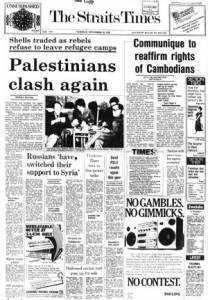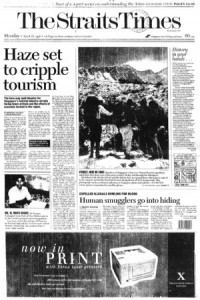Keeping up with the times – the changing look of Singapore’s longest surviving English newspaper The Straits Times.
— — — — — — — — — — — — — — — — — — — — — — — —
Introduction } 1960s } 1970s } 1980s } 1989 } 1998 } 2000s
— — — — — — — — — — — — — — — — — — — — — — — —
The spur to modernise ST’s design came when a competing newspaper, the Singapore Monitor, entered the market in 1982. By then, Khoo had already retired from ST a year earlier and the paper was now helmed by Peter Lim as group editor[i] and Cheong Yip Seng as editor.
The new team increased the size of the paper[ii] and adopted a “new and more flexible”[iii] editorial voice. Instead of two separate editorials in an issue, it reduced it to just one with the title “The Straits Times says…”.
Lim’s direction for ST was “to design the front page for mass-appeal with in-depth reports on the inside pages, and to make one section popular, while concentrating serious quality material in the other.”[iv]
Such a view was steeped in scientific management, a call for order and efficiency that was also guiding Singapore’s developmental aspirations then.
Prior to this, the paper had developed a page flow over the years: top news, foreign news, local news, sports and entertainment. It was only from December 1983 that these sections were made prominent. Each page was headed with a livery containing its section name typeset in Helvetica and accompanied by an icon.
News snippets, which used to clutter spaces leftover from the main stories, were all housed in mini sections such as World Briefs. Similarly, small advertisements came under a Classifieds section that eventually moved out of the main paper and stood as the third part of ST. These changes gave each page a more regular look – usually one or two big advertisements accompanied by three to four news stories.
To create a more efficient read, the assortment of headline typefaces was replaced with just one in several weights. The index was fully expanded to a full-page In Summary and moved to page two of the now forty-page production.
Forced out of its complacency by the Singapore Monitor, ST became a livelier-looking paper. But this competition came to a close in 1984 when the English, Chinese and Malay newspapers in Singapore came together to form the Singapore Press Holdings (SPH) to avoid battling for scarce resources. A year later, as Singapore entered its first recession since independence, the money-losing Singapore Monitor was closed.
— — — —
- [i] Turnbull, 326.
- [ii] Ibid., 331.
- [iii] Inside the Editorial,” The Straits Times, October 28 1981.
- [iv] Turnbull, 332.
— — — —


